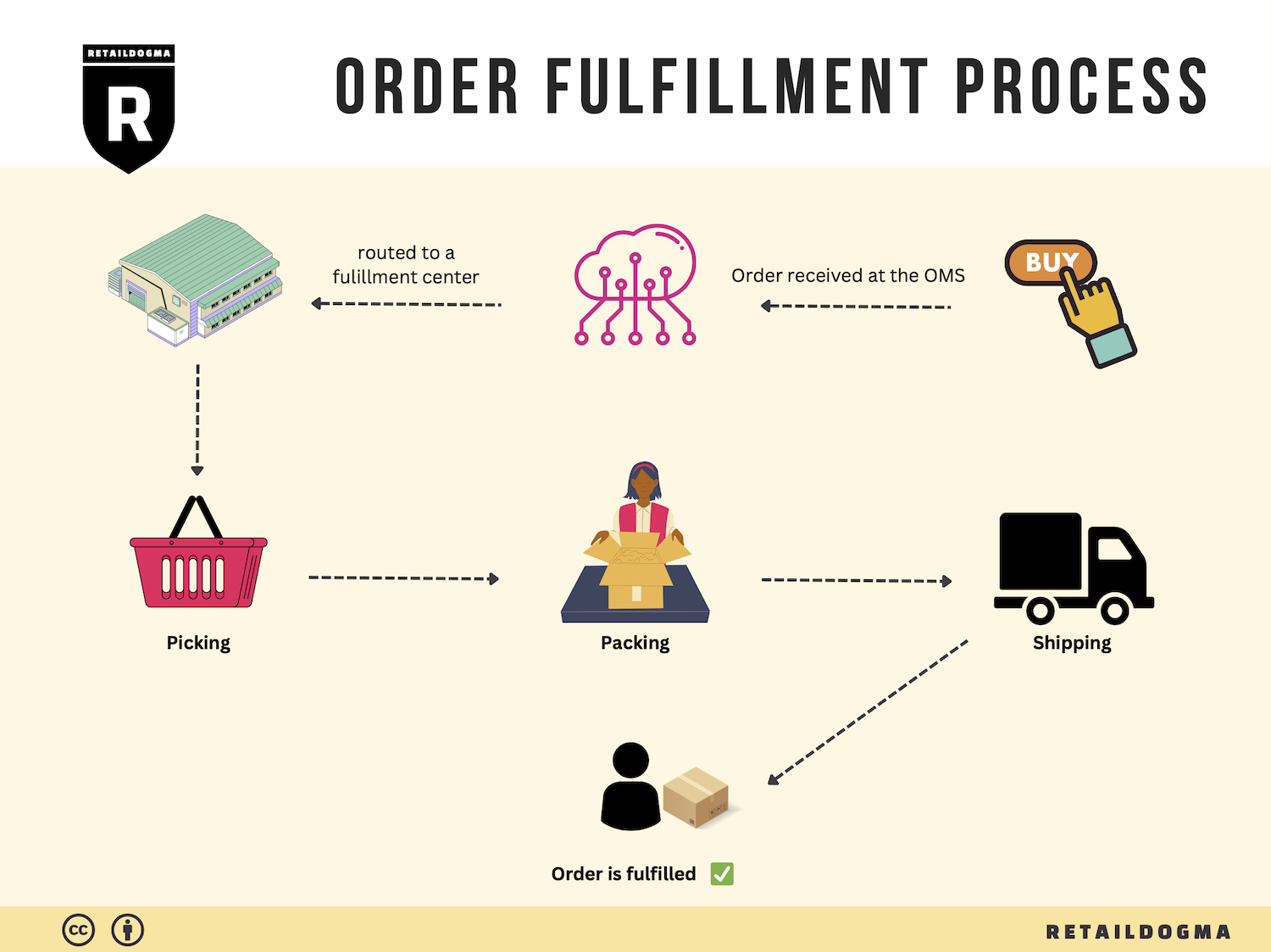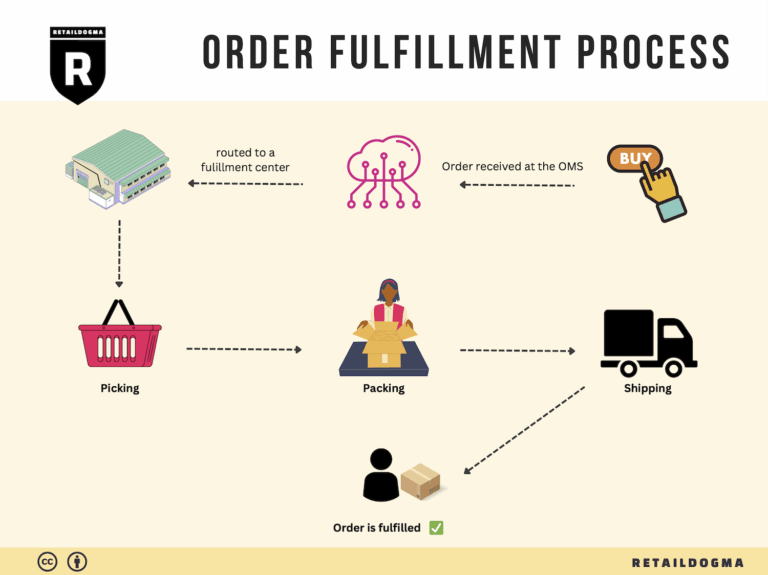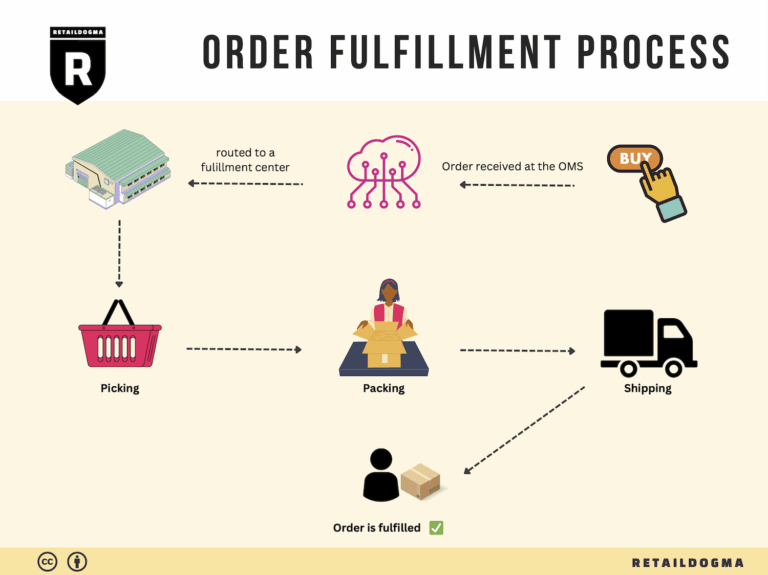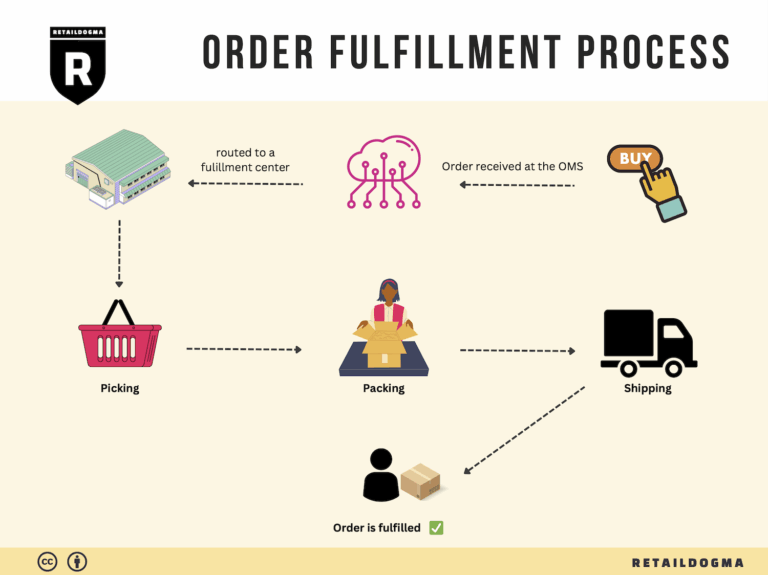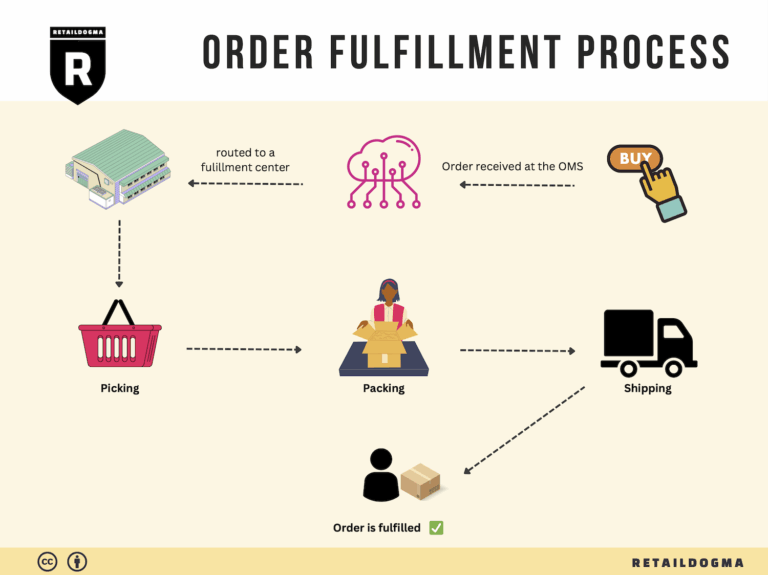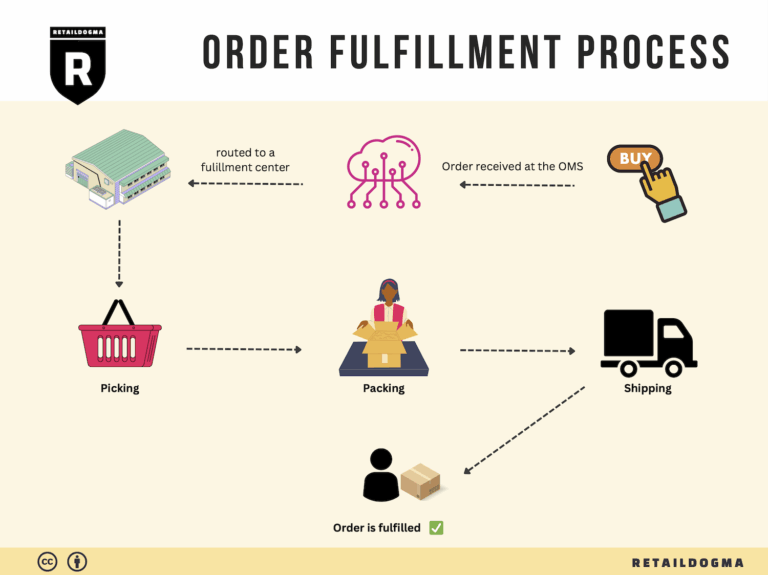Ecommerce Fulfillment Services: The Ultimate Guide (2025)
What is E-commerce Fulfillment? An Introduction for Growing Businesses
Understanding the Challenges of Order Fulfillment
As a growing e-commerce business owner, you might find yourself overwhelmed with the complexities of packing and shipping orders. Managing inventory, ensuring timely delivery, and maintaining customer satisfaction can quickly become a daunting task. This is where the concept of fulfillment comes into play. Fulfillment is simply the process of getting a product from your inventory to your customer’s doorstep. However, navigating this process effectively is crucial for scaling your operations and ensuring customer loyalty.
What This Guide Covers
In this comprehensive guide, we will explore the various models of fulfillment that are available to e-commerce businesses, including Third-Party Logistics (3PL) and Fulfillment by Amazon (FBA). Understanding these models will help you identify which one aligns best with your business goals and operational capabilities.
We will delve into the core services offered by fulfillment partners, such as inventory management, order processing, packing, shipping, and returns handling. Each service plays a critical role in the overall efficiency of your supply chain and can significantly impact your customer experience.
Additionally, choosing the right fulfillment partner can be a game-changer for your business. We will provide you with practical tips on what to look for in a fulfillment partner, including factors like location, technology integration, and scalability options.
Pricing is another essential aspect that will be covered in this guide. Understanding the cost structures associated with different fulfillment models will enable you to budget effectively and make informed financial decisions.
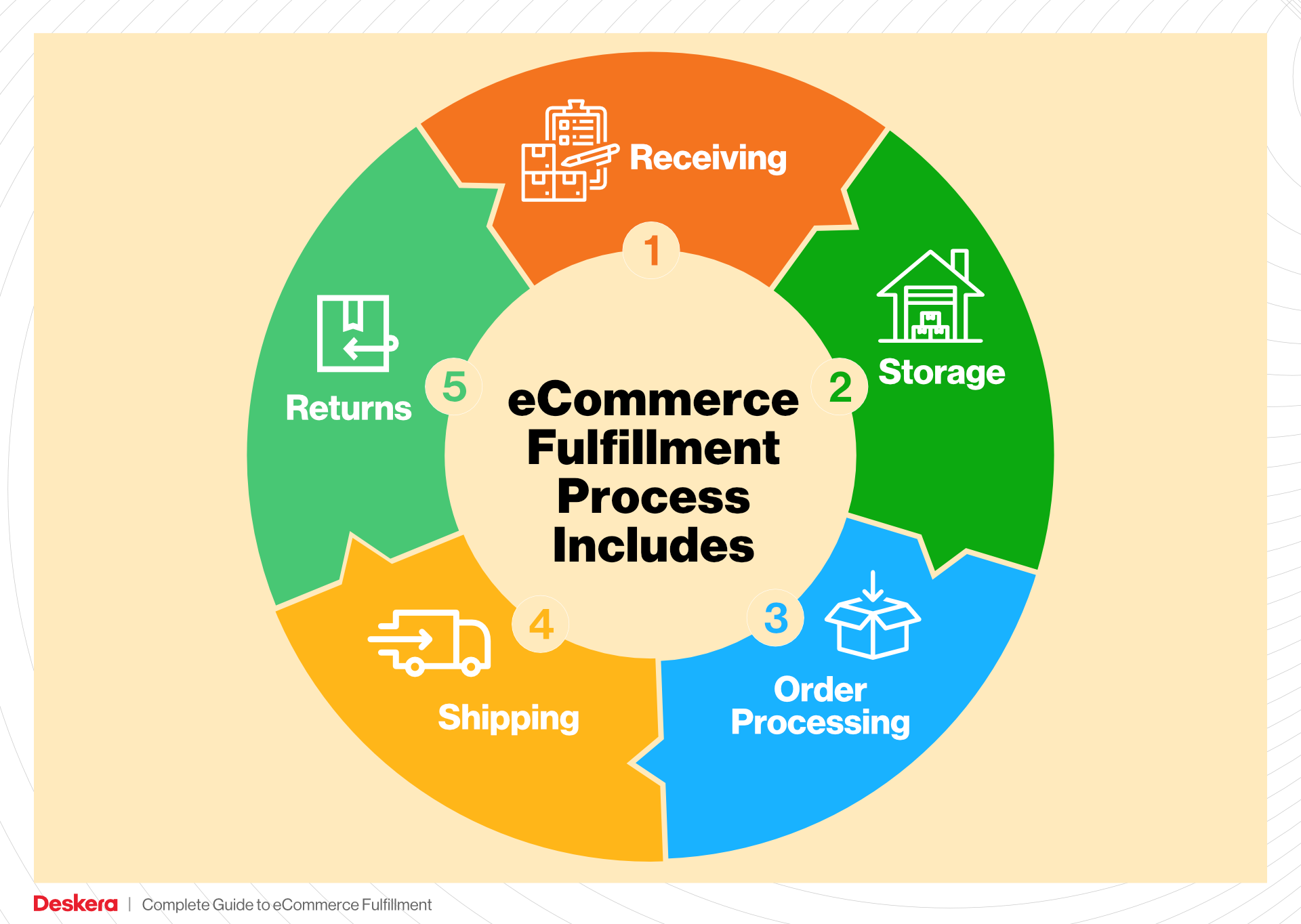
Empowering Smart Logistics Decisions
The ultimate goal of this guide is to empower you, as an e-commerce business owner, to make informed decisions about your logistics strategy. By providing you with insights into the various fulfillment options, services, and pricing models, we aim to equip you with the knowledge needed to optimize your order fulfillment processes. This will not only help you streamline your operations but also enhance your customer satisfaction, leading to sustainable growth in your e-commerce venture.
Let’s embark on this journey to demystify e-commerce fulfillment and set the stage for your business’s success.
What You’ll Learn In This Guide
- What is E-commerce Fulfillment? An Introduction for Growing Businesses
- The Order Fulfillment Process: From ‘Buy’ Button to Customer’s Door
- Comparing Fulfillment Models: In-House vs. 3PL vs. Dropshipping
- A Deep Dive into Amazon FBA: Pros, Cons, and Who It’s For
- Core Services Offered by Fulfillment Centers
- How to Choose a Fulfillment Partner: A 6-Point Checklist
- Understanding Fulfillment Pricing: A Breakdown of Common Fees
- Frequently Asked Questions (FAQs) about Fulfillment
- Conclusion: Is Outsourcing Fulfillment the Right Move for Your Business?
- Important Disclaimer
The Order Fulfillment Process: From ‘Buy’ Button to Customer’s Door
1. Receiving Inventory
The order fulfillment process begins with the receiving of inventory at the fulfillment center. This critical step involves the acceptance of goods from suppliers or vendors, which are then logged into the system. During this phase, each item is assigned a Stock Keeping Unit (SKU), a unique identifier that helps track inventory levels and manage stock efficiently.
Receiving inventory is vital for several reasons. It ensures that the fulfillment center has the products needed to fulfill customer orders promptly. Additionally, accurate receiving minimizes discrepancies between the ordered and received goods, which can lead to stockouts or overstock situations. By employing technology such as barcode scanners and automated inventory management systems, businesses can streamline this process and maintain accurate records, setting the stage for effective order fulfillment.
2. Warehouse Storage
Once the inventory is received and logged, the next step is warehouse storage. During this phase, products are carefully stowed in designated areas within the fulfillment center. This organization can be based on various criteria, including product type, size, or demand frequency. Efficient storage practices ensure easy access to items when orders are placed.
Effective warehouse storage is essential for optimizing space and enhancing retrieval times. By implementing a systematic storage approach, such as ABC analysis (which categorizes inventory based on importance), businesses can ensure that high-demand products are easily accessible, reducing the time it takes to pick items for shipment. Proper storage solutions not only maximize the use of space but also improve overall operational efficiency.
3. Order Picking
When a customer places an order, the next step in the fulfillment process is order picking. This involves selecting the correct items from their storage locations based on the details of the order. A pick list—a document or digital tool that outlines what needs to be collected—guides fulfillment associates in this task.
Order picking is crucial as it directly impacts order accuracy and customer satisfaction. Errors in picking can lead to incorrect shipments, resulting in returns and additional costs. To enhance picking efficiency, many fulfillment centers use advanced technologies such as pick-to-light systems or voice-directed picking, which streamline the process and reduce the chance of errors. Efficient picking processes not only improve order turnaround times but also enhance the overall customer experience.
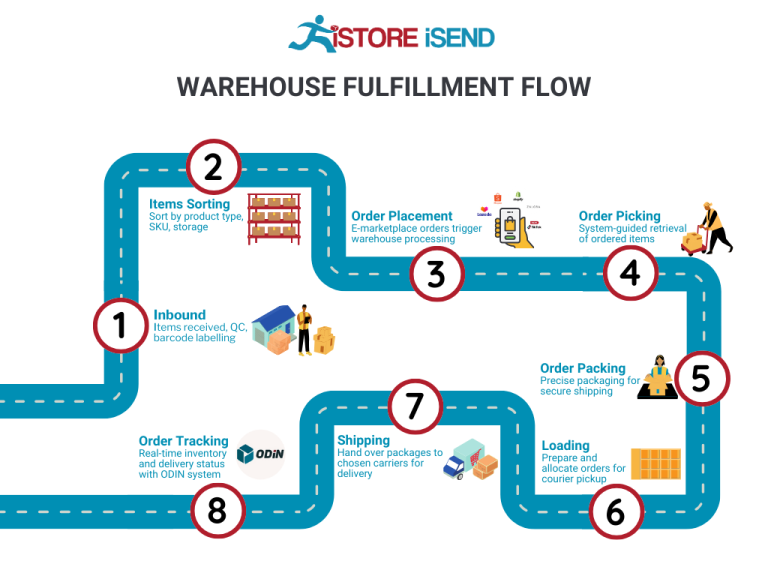
4. Order Packing
After items have been picked, they move to the order packing stage. This step involves carefully packaging the products to protect them during transit and preparing them for shipment. Proper packing materials, such as bubble wrap, packing peanuts, and sturdy boxes, are essential to ensure that products arrive at the customer’s door in perfect condition.
Packing is important not only for the protection of goods but also for branding and customer satisfaction. A well-packaged order can create a positive unboxing experience, reinforcing the customer’s decision to shop with your business. Furthermore, businesses can utilize packing slips and shipping labels that contain order information and tracking details, which enhances transparency and communication with the customer.
5. Shipping & Delivery
The final step in the order fulfillment process is shipping and delivery. Once the orders are packed, they are labeled and prepared for dispatch to the customer. This stage involves coordinating with carriers and logistics partners to ensure timely delivery. Businesses often utilize shipping management software to streamline this process, allowing for real-time tracking and updates.
Shipping and delivery are critical as they significantly influence customer satisfaction and retention. Delays or complications in this phase can lead to frustrated customers and potential loss of sales. By selecting reliable carriers and optimizing shipping routes, businesses can enhance delivery speed and reliability. Additionally, offering various shipping options, such as express or standard delivery, can cater to diverse customer preferences and improve overall service levels.
By understanding and efficiently executing each step of the order fulfillment process, e-commerce businesses can not only scale their operations but also significantly enhance customer satisfaction and loyalty.
Comparing Fulfillment Models: In-House vs. 3PL vs. Dropshipping
Comparison of Fulfillment Models
| Model | Who Handles Inventory | Best For (Business Stage) | Key Advantage | Key Disadvantage |
|---|---|---|---|---|
| In-House Fulfillment | Business (Owner/Staff) | Established businesses with stable demand | Full control over inventory and processes | High overhead costs and resource demands |
| Third-Party Logistics (3PL) | Third-party provider | Growing businesses seeking scalability | Cost-effective and efficient logistics | Less control over fulfillment processes |
| Dropshipping | Supplier | Startups and small businesses | Low upfront investment and risk | Potential quality control issues and longer shipping times |
In-House Fulfillment
In-house fulfillment refers to the process where a business manages its own inventory and logistics operations. This model is best suited for established companies with stable demand and a well-defined customer base. By controlling all aspects of fulfillment, including inventory management, packing, and shipping, businesses can tailor their processes to align closely with customer expectations and brand standards. The primary advantage of in-house fulfillment is the complete control it offers; businesses can oversee every aspect of their operations, ensuring consistency in quality and service. However, this control comes at a cost. The overhead involved in maintaining a warehouse, hiring staff, and managing logistics can be significant. Additionally, as order volumes grow, scaling operations can become cumbersome, requiring further investment in infrastructure and personnel.
Third-Party Logistics (3PL)
Third-party logistics (3PL) providers offer businesses the opportunity to outsource their fulfillment operations to specialized companies. This model is ideal for growing businesses that require scalability without the burden of managing logistics in-house. 3PL providers handle everything from inventory storage and order picking to packing and shipping, allowing businesses to focus on core activities like marketing and product development. The key advantage of using a 3PL is cost-effectiveness; companies can leverage the provider’s infrastructure and expertise without incurring the high costs associated with in-house fulfillment. However, one significant disadvantage is the loss of control over the fulfillment process. Businesses must rely on their 3PL partner to maintain service levels and quality, which can vary widely between providers. Additionally, if a 3PL faces operational issues, it can directly impact the business’s ability to meet customer expectations.
Dropshipping
Dropshipping is a fulfillment model where the retailer does not hold any inventory but instead relies on suppliers to ship products directly to customers upon receiving an order. This model is particularly advantageous for startups and small businesses, as it requires minimal upfront investment and eliminates the need for warehousing and inventory management. The primary benefit of dropshipping is the low financial risk; businesses only pay for products after they have been sold, allowing for a flexible approach to inventory management. However, dropshipping also comes with its challenges. Businesses often face potential quality control issues, as they do not handle the products themselves, leading to discrepancies in product quality or shipping times. Furthermore, longer shipping times can occur since products are shipped from suppliers rather than a local warehouse, which can frustrate customers expecting quick delivery. This model requires careful supplier selection and strong communication to ensure a smooth fulfillment process.
In summary, each fulfillment model presents unique advantages and challenges. In-house fulfillment provides control but at a high cost, 3PL offers scalability and efficiency but reduces direct oversight, and dropshipping minimizes risk but can complicate quality assurance. Business owners must carefully evaluate their operational needs, growth potential, and customer expectations when selecting the most suitable fulfillment strategy.
A Deep Dive into Amazon FBA: Pros, Cons, and Who It’s For
Understanding Fulfillment by Amazon (FBA)
Fulfillment by Amazon (FBA) is a service that allows e-commerce sellers to utilize Amazon’s extensive logistics network for their own products. By enrolling in FBA, sellers send their inventory to Amazon’s fulfillment centers, where Amazon takes care of storage, packaging, and shipping of products directly to customers. This service not only simplifies the logistics process for sellers but also enhances the customer experience, as it leverages Amazon’s established reputation for fast and reliable delivery.
How FBA Works
-
Inventory Preparation and Shipment: Sellers prepare their products according to Amazon’s guidelines and ship them to one or more of Amazon’s fulfillment centers. The inventory is received and stored until an order is placed.
-
Order Processing: When a customer orders a product, Amazon handles the entire fulfillment process. This includes picking the item from the warehouse, packing it securely, and shipping it to the customer.
-
Customer Service and Returns: Amazon also manages customer service inquiries related to FBA orders, including returns and refunds, ensuring a seamless experience for both the seller and the buyer.
-
Multi-Channel Fulfillment: Sellers can also use FBA to fulfill orders from other sales channels outside of Amazon, such as their own website or other e-commerce platforms, making it a versatile solution for managing logistics.

Pros of Fulfillment by Amazon (FBA)
-
Prime Eligibility: One of the most significant advantages of using FBA is the ability to offer products with Amazon Prime eligibility. This attracts millions of Prime members who prefer fast, free shipping, significantly increasing the potential for sales.
-
Customer Trust and Brand Credibility: Products fulfilled by Amazon often gain more trust from customers due to Amazon’s reputation for reliability and quality service. This can lead to higher conversion rates and customer loyalty.
-
Simplified Logistics: FBA takes the burden of storage, packing, and shipping off the seller’s shoulders. This allows sellers to focus on other aspects of their business, such as marketing and product development, without getting bogged down in logistics.
-
Scalability: As businesses grow, FBA can easily scale with them. Sellers can increase their inventory without needing to invest in additional warehousing or logistics infrastructure.
-
Multi-Channel Fulfillment: FBA enables sellers to fulfill orders from various platforms beyond Amazon, providing flexibility in managing sales across different channels.
-
Access to Analytics and Reporting: Amazon provides valuable insights through its Seller Central dashboard, helping sellers track performance, inventory levels, and sales trends, which can inform future business decisions.
Cons of Fulfillment by Amazon (FBA)
-
High Fees: While FBA offers many conveniences, it comes at a cost. Sellers must pay various fees, including storage fees for inventory stored in Amazon’s fulfillment centers and fulfillment fees for each order shipped. These costs can add up, especially for smaller sellers or those with low-margin products.
-
Strict Inventory Rules: Amazon has stringent guidelines regarding inventory management, including how products should be packaged and labeled. Non-compliance can result in additional fees or even the rejection of shipments.
-
Commingling Risks: FBA utilizes a commingled inventory system, where products from different sellers are stored together. This can lead to concerns about counterfeit goods or quality issues, as sellers may receive returns or complaints about products that were not theirs.
-
Loss of Control: By outsourcing fulfillment to Amazon, sellers relinquish some control over the customer experience, including packaging and shipping times, which may not always align with their brand standards.
-
Inventory Management Challenges: Sellers need to effectively manage their inventory levels to avoid long-term storage fees for unsold products and potential stockouts during peak sales periods.
Who is FBA Best For?
Fulfillment by Amazon is particularly advantageous for:
-
Small to Medium-Sized E-commerce Businesses: Businesses looking to scale quickly without the overhead of managing their own fulfillment can benefit significantly from FBA’s infrastructure.
-
Sellers with High-Volume Sales: Those who anticipate a high volume of orders and can manage inventory effectively will find FBA’s services cost-effective.
-
New Sellers: Entrepreneurs entering the e-commerce space can leverage FBA to gain immediate access to Amazon’s vast customer base and infrastructure, allowing them to focus on marketing and product development.
-
Brands Seeking Prime Eligibility: If a business aims to attract Amazon Prime customers, FBA is essential, as it provides the necessary logistics to offer Prime shipping.
In conclusion, Fulfillment by Amazon offers a powerful solution for e-commerce businesses looking to streamline their operations and tap into Amazon’s extensive customer base. While it presents certain challenges, particularly regarding fees and inventory management, the benefits often outweigh the drawbacks for many sellers. By understanding the nuances of FBA, businesses can effectively leverage this service to enhance their growth and customer satisfaction.
Core Services Offered by Fulfillment Centers
Inventory Management & Warehousing
Inventory management and warehousing are foundational services provided by fulfillment centers, crucial for any e-commerce business aiming to optimize its supply chain. This service involves the systematic tracking, storing, and organizing of products within the fulfillment center.
Fulfillment centers employ advanced inventory management systems that utilize barcode scanning, RFID technology, and real-time data analytics to ensure accurate inventory counts and minimize discrepancies. This allows businesses to have a clear view of stock levels, enabling them to make informed decisions about reordering and managing their supply chain effectively.
Benefits:
1. Improved Accuracy: Enhanced tracking systems reduce errors in order fulfillment, ensuring customers receive the correct products.
2. Cost Efficiency: By consolidating inventory in a centralized location, businesses can reduce overhead costs associated with multiple storage facilities.
3. Scalability: As your business grows, fulfillment centers can easily accommodate increased inventory levels without the need for significant investment in infrastructure.
4. Flexibility: Businesses can adapt to seasonal fluctuations and market demands by adjusting their inventory levels without the burden of managing physical space.
Pick and Pack Services
Pick and pack services are integral to the order fulfillment process within a fulfillment center. This service entails selecting the correct items from inventory, packing them securely, and preparing them for shipment. Fulfillment centers streamline this process using advanced picking technologies and efficient packing strategies.
Using methods like batch picking, wave picking, or zone picking, fulfillment centers can expedite the order fulfillment process. Once items are picked, they are packed according to specific requirements, ensuring that products are protected during transit.
Benefits:
1. Speed: Efficient picking methods significantly reduce the time taken to fulfill orders, allowing businesses to meet customer expectations for fast shipping.
2. Customization: Fulfillment centers often offer tailored packing options, including branded packaging or gift-wrapping, enhancing the customer experience.
3. Reduced Labor Costs: Outsourcing pick and pack services allows e-commerce businesses to minimize staffing needs and focus on core operations.
4. Error Reduction: Automated systems and trained staff minimize the likelihood of picking errors, improving overall customer satisfaction.
Kitting and Assembly
Kitting and assembly services involve the grouping of individual items into a single package or kit, which is especially beneficial for e-commerce businesses that sell products that are often bundled together. This service can also include assembling products that require some level of construction or configuration before they are shipped to customers.
Fulfillment centers manage the entire kitting process, from sourcing the necessary components to assembling them and packaging them for shipment. This is particularly useful for businesses that offer subscription boxes, promotional bundles, or multi-component products.
Benefits:
1. Enhanced Product Offerings: Kitting allows businesses to create unique product bundles that can attract more customers and increase average order value.
2. Operational Efficiency: By outsourcing kitting and assembly, businesses can free up internal resources and reduce the complexity of their operations.
3. Inventory Control: Fulfillment centers can manage the inventory of each component, ensuring that all necessary items are in stock and ready for assembly.
4. Time Savings: Streamlined kitting processes enable faster turnaround times, ensuring that bundled products reach customers quickly.
Returns Management (Reverse Logistics)
Returns management, or reverse logistics, is a critical service provided by fulfillment centers that focuses on handling product returns efficiently. This includes receiving returned items, inspecting them, restocking them, or processing them for disposal or refurbishment.
A well-managed returns process is essential for maintaining customer satisfaction and loyalty, as it directly impacts the shopping experience. Fulfillment centers utilize efficient systems to manage returns, ensuring that they are processed quickly and accurately.
Benefits:
1. Customer Satisfaction: A seamless returns process enhances the customer experience, encouraging repeat purchases and positive reviews.
2. Cost Management: By efficiently managing returns, businesses can minimize losses associated with returned merchandise and optimize their inventory.
3. Data Insights: Analyzing return data can provide valuable insights into product quality, customer preferences, and potential areas for improvement in the product offering.
4. Resource Allocation: Fulfillment centers can handle returns, allowing e-commerce businesses to focus their resources on growth and customer acquisition rather than reverse logistics.
In conclusion, leveraging the core services of fulfillment centers—inventory management and warehousing, pick and pack services, kitting and assembly, and returns management—can significantly enhance the operational efficiency of e-commerce businesses. By outsourcing these functions, entrepreneurs can focus on scaling their sales and developing their brand, while ensuring their logistics are handled by experts in the field.
How to Choose a Fulfillment Partner: A 6-Point Checklist
Location & Warehouse Network
Choosing a fulfillment partner with strategically located warehouses can significantly impact your shipping times and costs. A partner with multiple warehouses across key regions allows for faster delivery to your customers, which can enhance customer satisfaction and reduce shipping expenses.
Key Questions to Ask:
– Where are your warehouses located, and how does this align with my target market?
– Do you have the capacity to expand your warehouse network as my business grows?
– How do you manage inventory across different locations to ensure accuracy and efficiency?
Technology & Integrations
In today’s digital landscape, the technology used by your fulfillment partner is crucial for seamless operations. A robust fulfillment system should integrate easily with your e-commerce platform, providing real-time inventory updates, order tracking, and analytics.
Key Questions to Ask:
– What technology do you use for inventory management and order processing?
– Can your system integrate with my existing e-commerce platform (e.g., Shopify, Amazon)?
– Do you offer API access for custom integrations or reporting?
Specializations (e.g., Cold Storage, Oversized Items)
Depending on your product offerings, it’s essential to assess whether a fulfillment partner has the necessary capabilities to handle your specific needs. For example, if you sell perishable goods, a partner with cold storage facilities is vital. Similarly, if your products are oversized or require special handling, ensure the partner has experience in those areas.
Key Questions to Ask:
– What types of products do you specialize in handling?
– Do you have specific facilities for temperature-sensitive items or oversized goods?
– Can you accommodate unique packing or shipping requirements?
Scalability & Capacity
As your business grows, your fulfillment needs will evolve. It’s important to partner with a fulfillment provider that can scale operations to meet increasing demand without compromising service quality. This includes having the physical space and operational capacity to handle fluctuations in order volume.
Key Questions to Ask:
– How do you handle peak seasons or sudden spikes in order volume?
– What is your current capacity, and how quickly can you scale up?
– Can you provide case studies or examples of how you’ve supported growing businesses?
Pricing and Contracts
Understanding the cost structure and contract terms of your fulfillment partner is critical for maintaining profitability. Look for transparency in pricing, including any additional fees for services like storage, packaging, and shipping.
Key Questions to Ask:
– What is your pricing model (e.g., per order, per item, monthly fees)?
– Are there any hidden fees I should be aware of?
– What are the terms regarding contract length and termination?
Customer Support & Reviews
Reliable customer support can make a significant difference in your fulfillment experience. A partner who offers prompt and effective support can help resolve issues quickly, ensuring your operations run smoothly. Additionally, researching customer reviews can provide insights into the partner’s reliability and service quality.
Key Questions to Ask:
– What support channels do you offer (e.g., phone, email, live chat)?
– What are your average response times for customer inquiries?
– Can you provide references or testimonials from current or past clients?
Conclusion
Choosing the right fulfillment partner is a critical decision that can impact your business’s efficiency, customer satisfaction, and overall growth. By following this checklist and asking the right questions, you can make an informed decision that aligns with your operational goals and customer expectations. Remember, the right partner will not only support your current needs but will also be a strategic ally as your business scales.
Understanding Fulfillment Pricing: A Breakdown of Common Fees
Initial Setup Fees
When partnering with a fulfillment center, the initial setup fees often represent the first investment in your logistics strategy. These fees can include costs associated with onboarding your account, integrating your systems with the fulfillment center’s platform, and any necessary training for your staff on how to use the fulfillment services effectively.
Calculation: Initial setup fees can vary significantly based on the complexity of your operations and the fulfillment center’s requirements. Some centers may charge a flat fee, while others may base it on the volume of products you plan to store and fulfill. It’s essential to clarify what services are included in this fee to avoid unexpected costs later on.
Receiving Fees
Receiving fees are incurred when inventory is delivered to the fulfillment center. This fee covers the labor and resources needed to unload, inspect, and process incoming shipments.
Calculation: Typically, receiving fees are calculated based on the number of pallets or units delivered. Some fulfillment centers may charge a flat rate per pallet, while others might have tiered pricing based on the volume of goods received. It’s crucial to understand the specific requirements of the fulfillment center regarding labeling and packaging to minimize additional charges.
Storage Fees (per pallet/bin)
Storage fees are charged for the space your products occupy within the fulfillment center. This fee can be calculated on a per-pallet or per-bin basis, depending on how the center organizes its inventory.
Calculation: Storage fees are often charged monthly and can vary based on the size of the pallet or bin. Some centers may implement a tiered pricing structure where the cost per pallet decreases as the number of pallets increases. Additionally, be aware that many fulfillment centers charge higher fees for long-term storage, typically for items stored longer than six or twelve months. To optimize costs, regularly review your inventory turnover rates and consider removing slow-moving items.
Pick & Pack Fees (per item/order)
Pick and pack fees are associated with the process of selecting items from inventory and preparing them for shipment. This fee usually covers labor, materials (like boxes and packing materials), and any associated handling costs.
Calculation: Pick and pack fees are generally charged on a per-item or per-order basis. Some fulfillment centers may charge a flat fee for orders up to a certain number of items, with additional fees for each item beyond that limit. Understanding how these fees are structured can help you predict costs accurately, especially if you have a diverse product range or frequently run promotions that may increase order volume.
Shipping Fees
Shipping fees cover the cost of transporting the packaged orders to the end customer. These fees can vary widely based on factors such as the destination, shipping method, and package size.
Calculation: Shipping fees are typically calculated based on the weight and dimensions of the package, the shipping distance, and the selected shipping service (e.g., standard, expedited, international). Many fulfillment centers have partnerships with carriers that can offer discounted rates, so it’s beneficial to inquire about these arrangements. Additionally, consider offering multiple shipping options to customers, as this can affect your overall shipping costs and customer satisfaction.
Tips for Getting an Accurate Quote
-
Be Transparent About Your Needs: Clearly communicate your product dimensions, expected order volume, and any specific requirements to the fulfillment center. This transparency helps them provide a more accurate quote.
-
Request a Detailed Breakdown: Ask for a detailed list of all potential fees, including any ancillary charges that may apply. This can help prevent unexpected costs later.
-
Consider Volume Discounts: Inquire about volume discounts for storage, pick & pack, and shipping fees, especially if you anticipate rapid growth in your sales.
-
Review Contracts Carefully: Before signing any agreements, review the terms and conditions thoroughly. Pay attention to clauses related to fee increases or changes in service levels.
-
Ask About Integrations: If you use specific software for inventory management or order processing, ensure that the fulfillment center can integrate smoothly with your systems. This can save time and reduce errors, impacting your overall costs.
By understanding these common fulfillment pricing models and diligently evaluating potential fulfillment partners, you can make informed decisions that enhance your operational efficiency and contribute to your e-commerce success.
Frequently Asked Questions (FAQs) about Fulfillment
1. What is the Amazon Fulfillment Center-CMH3?
The Amazon Fulfillment Center-CMH3, located in Monroe, Ohio, is a facility dedicated to processing and fulfilling customer orders placed on Amazon. It is part of Amazon’s vast logistics network that ensures efficient delivery of a wide range of products, supporting the company’s commitment to customer satisfaction through timely order fulfillment.
2. What services does the CMH3 fulfillment center offer?
The CMH3 fulfillment center provides various services including inventory receiving, storage, order picking, packing, and shipping. It also supports the Fulfillment by Amazon (FBA) program, allowing sellers to store their products in Amazon’s warehouses and have them shipped directly to customers.
3. How does the order fulfillment process work at CMH3?
The order fulfillment process at CMH3 involves several key steps:
1. Inventory Receiving: Products are received and checked in.
2. Storage: Items are organized and stored in designated areas.
3. Order Picking: When a customer places an order, the system identifies the location of the items, and fulfillment associates retrieve them.
4. Packing: The picked items are packed securely for shipment.
5. Shipping: The packed orders are dispatched to customers via various delivery methods.
4. What is the difference between a warehouse and a fulfillment center?
A warehouse is primarily used for storage, while a fulfillment center is focused on processing and shipping orders. Fulfillment centers are equipped with advanced technology and systems to handle the entire order fulfillment process, including inventory management, packing, and shipping, whereas warehouses may simply store goods without such operations.
5. What is a 3PL?
A Third-Party Logistics (3PL) provider is a company that offers outsourced logistics services to businesses. This includes warehousing, fulfillment, and shipping. Utilizing a 3PL can help businesses scale their operations without investing in their own logistics infrastructure, allowing them to focus on core activities like marketing and product development.
6. How much do fulfillment services cost?
The cost of fulfillment services can vary widely based on factors such as the volume of orders, types of products, storage space required, and shipping methods used. Generally, costs may include storage fees, picking and packing fees, and shipping fees. It’s essential for businesses to analyze their specific needs and obtain quotes from fulfillment centers to understand the total cost.
7. What are the benefits of using the CMH3 fulfillment center for my e-commerce business?
Utilizing the CMH3 fulfillment center offers several benefits, including:
– Speed: Efficient processing and shipping ensure timely delivery to customers.
– Scalability: Easily scale operations without the need for significant investment in infrastructure.
– Access to Amazon’s Network: Leverage Amazon’s vast logistics and distribution network for broader reach.
– Customer Satisfaction: Enhanced service levels lead to improved customer satisfaction and loyalty.
8. Can I track my inventory at the CMH3 fulfillment center?
Yes, Amazon provides tools and systems for sellers to track their inventory stored at the CMH3 fulfillment center. Through the Seller Central dashboard, businesses can monitor inventory levels, manage stock replenishment, and view detailed reports on their products.
9. How do I get started with Fulfillment by Amazon at CMH3?
To start using Fulfillment by Amazon (FBA) at CMH3, you need to:
1. Create an Amazon Seller account.
2. Set up FBA in your account settings.
3. Prepare your products according to Amazon’s guidelines.
4. Ship your inventory to the CMH3 fulfillment center.
5. List your products for sale on Amazon, and they will be eligible for FBA.
10. What should I consider when choosing a fulfillment center like CMH3?
When selecting a fulfillment center such as CMH3, consider the following factors:
– Location: Proximity to your customer base can reduce shipping times and costs.
– Technology: Evaluate the technology used for inventory management and order processing.
– Pricing Structure: Understand the fee structure and ensure it aligns with your budget.
– Services Offered: Ensure the center can accommodate your specific needs, including handling returns and special packaging.
– Reputation: Research reviews and testimonials from other businesses that have used the fulfillment center.
Conclusion: Is Outsourcing Fulfillment the Right Move for Your Business?
Evaluating the Benefits of Outsourcing Fulfillment
Outsourcing fulfillment can be a transformative decision for e-commerce businesses looking to scale efficiently. By leveraging a fulfillment partner, such as Amazon Fulfillment Center CMH3, you can significantly save time and resources. This allows you to focus on core business activities like marketing and product development, rather than getting bogged down in logistics. With fulfillment specialists managing inventory, order processing, and shipping, you can streamline operations and enhance customer satisfaction through faster delivery times.
Another key advantage of outsourcing fulfillment is scalability. As your business grows, so too do your logistics needs. A fulfillment partner offers the infrastructure and resources to accommodate fluctuations in order volume, especially during peak seasons. This flexibility ensures you can respond swiftly to market demands without the overhead costs associated with expanding your own logistics capabilities.
Moreover, fulfillment centers bring invaluable expertise to the table. They are equipped with advanced technology and processes that optimize inventory management and shipping efficiency. Their experience can lead to improved order accuracy and reduced shipping errors, which ultimately enhances your brand’s reputation and customer loyalty.
However, the success of outsourcing fulfillment hinges on selecting the right partner. It’s crucial to choose a fulfillment service that aligns with your business goals and can support your growth trajectory. Factors to consider include location, technology capabilities, and customer service quality.
Call to Action
Take the first step toward a more efficient logistics strategy by auditing your current shipping process. Assess the time, costs, and resources involved, and determine if a fulfillment partner could enhance your operations. By making an informed decision, you can position your business for sustainable growth and improved customer satisfaction.
Important Disclaimer
⚠️ Important Disclaimer
The information in this guide is for educational purposes. Fulfillment services, pricing, and platform features change frequently. Always conduct your own due diligence and consult with providers directly before making business decisions.
